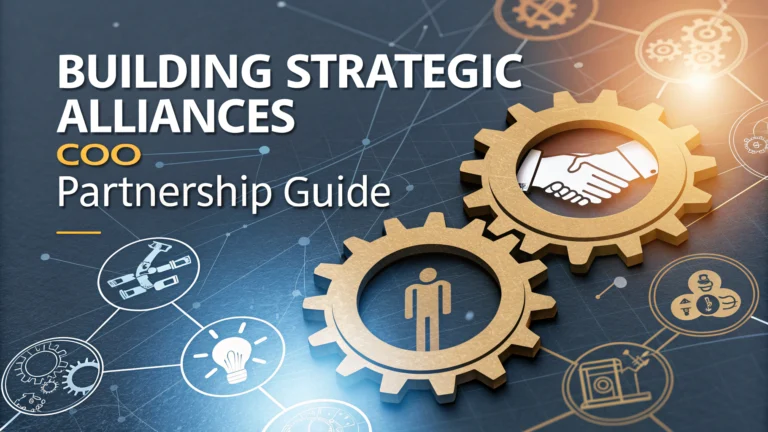Strategic alliances between Chief Operating Officers (COOs) and external partners can significantly boost operational efficiency and market reach.
Building the right partnerships requires careful evaluation of potential allies, clear communication of mutual benefits, and structured implementation processes.
This guide outlines practical steps for COOs to develop and maintain successful strategic partnerships that drive business growth.
Identifying the Right Strategic Partners
- Analyze market positioning and competitive advantages
- Evaluate cultural alignment and shared values
- Assess financial stability and resource compatibility
- Review operational capabilities and technical infrastructure
Partnership Assessment Checklist
| Criteria | Key Questions |
|---|---|
| Strategic Fit | Does the partnership align with long-term business goals? |
| Resource Complementarity | Do both parties bring unique strengths to the table? |
| Risk Assessment | What are the potential downsides and mitigation strategies? |
Structuring the Partnership Agreement
Draft clear, specific partnership agreements that outline roles, responsibilities, and expectations.
- Define governance structure and decision-making processes
- Establish KPIs and performance metrics
- Set resource allocation guidelines
- Include conflict resolution mechanisms
Implementation Best Practices
Create a dedicated partnership implementation team with representatives from both organizations.
- Schedule regular check-ins and progress reviews
- Document processes and procedures
- Implement shared communication platforms
- Set up data sharing protocols
Risk Management Strategies
Develop comprehensive risk management plans to protect both parties’ interests.
- Regular compliance audits
- Intellectual property protection measures
- Data security protocols
- Business continuity planning
Partnership Performance Metrics
| Metric Type | Examples |
|---|---|
| Financial | Revenue growth, cost savings, ROI |
| Operational | Process efficiency, delivery times |
| Strategic | Market share, customer satisfaction |
Communication Framework
Establish clear communication channels and protocols between partner organizations.
- Regular executive meetings
- Weekly operational updates
- Monthly performance reviews
- Quarterly strategic planning sessions
Moving Forward Successfully
Regularly review and adjust partnership strategies based on performance data and changing market conditions.
Schedule annual partnership health checks to ensure continued alignment with business objectives.
Consider expanding successful partnerships into new areas or markets when mutual benefits are clear.
For additional guidance on strategic partnerships, contact the Alliance of Strategic Partnership Professionals (ASPP) at [email protected] or visit their website at www.aspp.org.
Change Management and Integration
Effective change management is crucial for seamless partnership integration and long-term success.
- Develop comprehensive onboarding programs
- Provide cross-organizational training
- Address cultural differences proactively
- Create integration timelines and milestones
Technology Integration Framework
System Compatibility
- Assess current technology infrastructure
- Identify integration requirements
- Develop API and connectivity solutions
- Implement security protocols
Data Management
- Establish data sharing agreements
- Create unified reporting systems
- Implement data governance policies
- Monitor compliance requirements
Scaling Partnership Success
| Growth Area | Action Items |
|---|---|
| Market Expansion | Identify new territories, analyze market potential |
| Product Development | Joint innovation initiatives, shared R&D |
| Service Enhancement | Customer feedback integration, service optimization |
Maximizing Strategic Alliance Value
Strategic partnerships require continuous nurturing and adaptation to maintain their effectiveness and value creation potential.
- Monitor industry trends and market changes
- Leverage combined strengths for innovation
- Maintain flexibility in partnership structure
- Focus on sustainable growth opportunities
Building Lasting Partnership Success
The success of strategic alliances depends on commitment, transparency, and mutual value creation. Regular evaluation and adaptation of partnership strategies ensure continued relevance and effectiveness in achieving business objectives.
Remember that successful partnerships are built on trust, open communication, and shared vision for the future. By following these guidelines and maintaining focus on mutual benefits, COOs can create and sustain partnerships that drive significant business value.
Stay committed to continuous improvement and remain adaptable to evolving market conditions to ensure long-term partnership success.
FAQs
- What is the primary role of a COO in building strategic alliances?
A COO is responsible for evaluating potential partnerships, overseeing operational integration, ensuring alignment with company objectives, and managing the day-to-day execution of alliance agreements. - How should a COO assess potential strategic alliance partners?
A COO should evaluate partners based on strategic fit, cultural alignment, financial stability, operational compatibility, market position, and potential synergies while conducting thorough due diligence. - What are the key elements of a successful strategic alliance agreement?
The key elements include clearly defined objectives, roles and responsibilities, resource allocation, governance structure, performance metrics, risk-sharing mechanisms, and exit strategies. - How can COOs ensure effective communication between alliance partners?
COOs should establish regular communication channels, implement standardized reporting systems, create joint steering committees, and develop clear escalation protocols for issue resolution. - What metrics should COOs use to measure alliance success?
Key metrics include ROI, operational efficiency improvements, market share gains, cost savings, revenue growth, customer satisfaction scores, and achievement of specific partnership objectives. - How do COOs manage risk in strategic alliances?
COOs must implement risk management frameworks, conduct regular assessments, establish compliance protocols, monitor performance indicators, and maintain contingency plans for potential partnership challenges. - What role does technology integration play in strategic alliances?
Technology integration involves aligning IT systems, ensuring data security, establishing shared platforms, implementing compatible processes, and managing digital transformation initiatives between partners. - How should COOs handle conflicts between alliance partners?
COOs should establish clear dispute resolution mechanisms, maintain open communication channels, focus on mutual benefits, employ mediation when necessary, and ensure alignment with partnership agreements. - What are the common pitfalls in strategic alliance management?
Common pitfalls include unclear objectives, poor cultural fit, inadequate resource allocation, weak governance structures, misaligned expectations, and insufficient performance monitoring. - How can COOs ensure knowledge sharing between alliance partners?
COOs should create knowledge management systems, facilitate regular training sessions, establish best practice sharing protocols, and develop collaborative learning initiatives.
